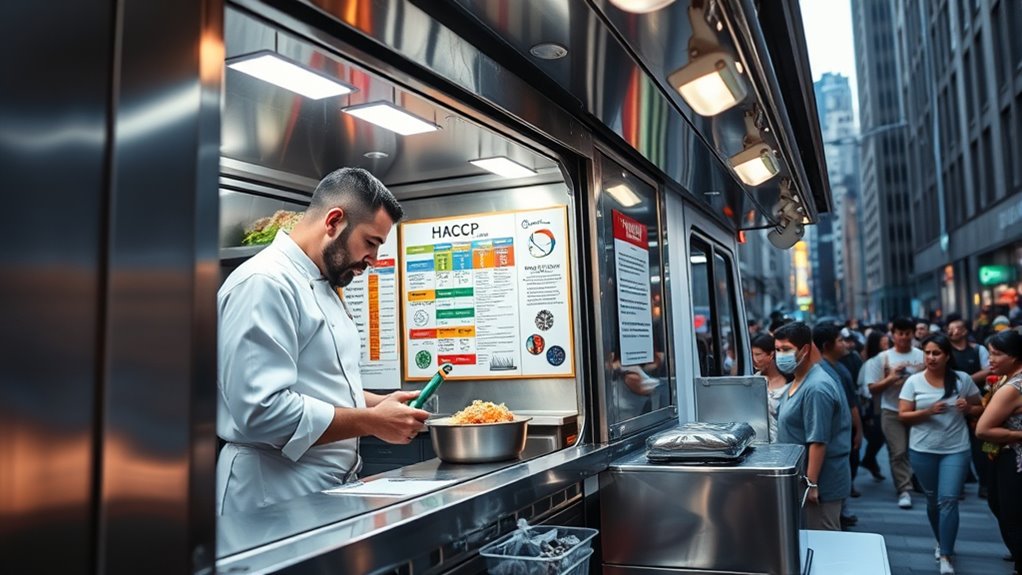To implement HACCP standards in your food truck, start by analyzing hazards specific to your mobile setup, like pests or temperature control. Identify critical points such as storage and cooking, then establish monitoring procedures like regular temperature checks and visual inspections. Train your staff on safety protocols and keep detailed records of all activities. Address issues immediately with corrective actions. Continuing with this guide will help you master the steps to guarantee your food safety compliance on the go.
Key Takeaways
- Conduct a thorough hazard analysis tailored to mobile environments, including pest control and supplier verification.
- Identify critical control points like temperature monitoring, storage, and cooking procedures specific to food truck operations.
- Implement regular monitoring using digital thermometers and detailed visual inspections to ensure compliance.
- Maintain comprehensive records of monitoring activities, corrective actions, and staff training for accountability.
- Train staff on HACCP protocols, emphasizing mobile-specific challenges and proper handling to uphold food safety standards.
Understanding the Basics of HACCP in the Context of Food Trucks

Understanding the basics of HACCP is essential for ensuring food safety on food trucks. This system helps you identify potential hazards that could compromise food safety and develop strategies to prevent them. HACCP focuses on hazard prevention by pinpointing critical points in your food handling process where risks are highest. By establishing clear procedures, you ensure that every step— from storage to cooking—meets safety standards. Implementing these principles means you’re proactively managing risks rather than reacting to problems after they occur. This approach not only protects your customers but also maintains your reputation and compliance with health regulations. Mastering the basics of HACCP gives you the foundation to build a safer, more reliable mobile food operation. Incorporating astrological compatibility insights can also help in team management and customer relations, enhancing overall service quality.
Conducting a Hazard Analysis Specific to Mobile Food Operations

How can you effectively identify hazards unique to mobile food operations? Start by examining risks specific to a mobile setting, like pests attracted to your food truck. Pest control becomes essential, as pests can contaminate food and compromise safety. Additionally, consider the reliability of your suppliers through supplier verification; unverified suppliers might deliver contaminated or unsafe ingredients. Always assess how food is stored and prepared on the move, noting potential cross-contamination points or temperature abuses. Recognize environmental hazards such as outdoor dust, debris, or nearby waste. By thoroughly analyzing these factors, you can pinpoint hazards that are unique to your mobile operation. This targeted hazard analysis forms the foundation for developing effective controls and ensuring your food truck remains safe and compliant.
Identifying Critical Control Points for Food Safety in a Mobile Setting

Once you’ve identified the hazards specific to your mobile food operation, the next step is to pinpoint the points in your process where controls can effectively prevent, eliminate, or reduce these risks. In a food truck setting, critical control points often include food storage, cooking, and temperature control. Ensuring proper handling and timely temperature checks is key to maintaining food safety. Just as strong food truck branding attracts customers, clear critical points attract focus to safety measures. You can use social media marketing to communicate your commitment to safety, reassuring customers about your HACCP implementation. Identifying these points helps streamline your operations and keeps safety at the forefront, ultimately protecting your customers and your reputation. Incorporating preventive controls into your procedures further enhances your food safety management system. Awareness of equipment functionality, such as modern toilets, can also support hygiene practices critical for food safety in your operations. Additionally, using HEPA filtration systems in your food truck can improve air quality and reduce airborne contaminants, contributing to a safer environment. Regular staff training on food safety protocols is essential to sustain these measures and ensure compliance. Understanding critical control points and their significance allows for more effective management of food safety risks in a mobile setting.
Establishing Monitoring Procedures Tailored to Food Truck Environments

To keep your food safe, you need reliable monitoring procedures suited for your food truck. Regular real-time temperature checks, visual inspections, and diligent recordkeeping help catch issues early. Implementing these practices guarantees you maintain control and meet HACCP standards on the move. Kia Tuning techniques can also be adapted to optimize your vehicle’s performance, ensuring smooth operations during service hours.
Real-time Temperature Checks
Effective monitoring of food temperatures in a food truck setting requires implementing real-time checks that are both reliable and adaptable to the environment. Temperature monitoring is essential for ensuring food safety and preventing bacterial growth. By performing real-time checks, you can immediately identify if temperatures fall outside safe ranges, allowing quick corrective actions. Use digital thermometers with probe sensors for accuracy and ease of use. Place them in critical control points, such as refrigeration units, cooked foods, and hot holding areas. Regularly record temperature readings and establish a schedule that fits your daily operations. This proactive approach helps maintain compliance with HACCP standards and reduces the risk of foodborne illnesses. Consistent, accurate real-time checks are your best defense against temperature-related hazards. Incorporating automation technologies can further improve monitoring accuracy and efficiency in your food truck operations. Additionally, training staff on proper temperature measurement techniques ensures ongoing food safety and compliance. Maintaining a monitoring schedule is crucial for consistent oversight and adherence to HACCP principles. Implementing real-time data logging can help track trends over time and identify recurring issues before they become critical.
Visual Inspection Protocols
Visual inspection protocols are essential for maintaining food safety in the dynamic environment of a food truck. You’ll rely on observing visual cues such as cleanliness, proper food storage, and equipment condition. Regularly conduct inspections using detailed checklists to guarantee no detail is overlooked. These checklists help you systematically verify that food prep areas are sanitized, temperatures are within safe ranges, and cross-contamination risks are minimized. By establishing routine visual inspections, you catch potential issues early, preventing foodborne illnesses. Train staff to recognize visual cues indicating spoilage or contamination and to promptly address these concerns. Consistent use of inspection checklists makes monitoring structured and effective, helping you maintain HACCP standards even when the truck is operating under tight schedules. Incorporating sound healing science principles, such as paying close attention to auditory cues like unusual noises from equipment, can further enhance your inspection process. Regularly reviewing food safety practices ensures your team stays current with best procedures and continuously improves inspection effectiveness. Additionally, understanding how contrast ratio impacts visibility can help in setting up optimal lighting conditions for inspections, ensuring all details are clearly visible. Using vertical storage solutions can also improve visibility and access to supplies, making inspections more efficient. Moreover, implementing proper lighting conditions tailored to the environment helps ensure all visual cues are easily detectable, promoting thorough inspections.
Recordkeeping Practices
Maintaining accurate records is essential for ensuring food safety and verifying that your food truck consistently meets HACCP standards. You should implement effective recordkeeping practices, utilizing digital documentation for ease and efficiency. Consistently monitor critical control points and store data securely to assure accessibility and compliance. To help you stay organized, consider this example:
| Monitoring Task | Record Details |
|---|---|
| Temperature Checks | Time, temperature, and location |
| Cleaning Schedules | Date, time, and responsible staff |
| Food Storage Conditions | Humidity, temperature, date |
| Supplier Deliveries | Date, items received, quality |
| Corrective Actions | Issue identified, resolution |
Using data storage solutions, you can quickly review records, identify trends, and ensure accountability. Digital records streamline compliance and support a safer food truck operation. Additionally, recordkeeping practices are vital for demonstrating compliance during inspections and audits.
Corrective Actions and Record Keeping for Food Truck HACCP Plans

When a deviation occurs in your food truck’s HACCP plan, it’s vital to document it clearly and accurately. You also need to take immediate corrective actions to address the issue and prevent future problems. Proper record keeping ensures you can track these incidents and demonstrate your commitment to food safety. Incorporating performance cookies helps monitor your compliance efforts and improve your HACCP processes over time. Regularly reviewing your attitude Shayari can also reinforce your understanding of maintaining effective corrective measures. Staying informed about divorce statistics highlights the importance of transparent documentation, which is essential for accountability in food safety management. Ensuring compliance with Louisiana Alimony Laws provides a framework for handling financial adjustments related to operational changes.
Documenting Deviations Properly
Properly documenting deviations is essential to maintaining food safety and ensuring your food truck’s HACCP plan remains effective. Accurate records help you track issues and demonstrate compliance, which also supports your food truck branding by showing your commitment to quality. When recording deviations, focus on clear, detailed descriptions, including date, time, and actions taken. Remember to always:
- Record the deviation promptly
- Note the specific problem and location
- Include corrective steps taken
- Document follow-up actions and results
This transparency not only safeguards your food safety but also boosts customer engagement by reassuring patrons that you prioritize their health. Consistent record-keeping builds trust and reinforces your food truck’s reputation as a responsible, safety-conscious business. Incorporating record-keeping best practices and understanding monitoring indicators ensures your documentation remains thorough and effective.
Implementing Corrective Measures
Once a deviation has been identified and documented, taking prompt corrective measures is vital to prevent food safety risks from escalating. You should implement immediate actions to address the issue, such as fixing equipment problems or adjusting procedures. Document every step taken, including the corrective action and its rationale, to guarantee accountability. Regular food safety audits help verify that corrective measures are effective and adhered to. Proper employee training is essential so staff understand how to respond appropriately when deviations occur. This knowledge ensures quick, consistent responses that minimize contamination risks. Keeping detailed records of corrective actions not only demonstrates compliance but also helps identify recurring issues, allowing you to improve your HACCP plan continuously. Prompt, documented corrective measures are key to maintaining food safety standards on your food truck.
Training Staff to Maintain Food Safety Standards on the Go

Training staff to maintain food safety standards on the go requires clear communication and practical skills that can be applied in real-time situations. You need to guarantee your team stays motivated and attentive to customer feedback, which often reflects cleanliness and safety levels. To do this effectively, focus on:
- Reinforcing the importance of hygiene and safety protocols regularly
- Using real-world scenarios to build confidence
- Encouraging open communication among staff
- Recognizing and rewarding good practices to boost motivation
When staff understand how their actions impact customer satisfaction, they’re more likely to stay committed. Motivated employees who listen to customer feedback prioritize cleanliness and safety, creating a trustworthy environment. Consistent training keeps everyone sharp and ready to handle safety challenges on the move.
Overcoming Challenges and Ensuring Compliance in Mobile Food Services

Operating in mobile food services presents unique challenges that can hinder compliance with HACCP standards if not addressed proactively. Mobile logistics, such as limited space and variable environments, make maintaining proper temperature controls and sanitation procedures more difficult. To overcome these issues, plan routes carefully to ensure access to reliable refrigeration and cleaning facilities. Additionally, permit requirements can complicate compliance—different jurisdictions may have varying regulations for food trucks. Staying informed about local permits and consistently updating your documentation helps prevent violations. Regular staff training on mobile-specific protocols ensures everyone understands how to adapt procedures on the go. By addressing these logistics and permit challenges head-on, you can maintain HACCP standards and operate smoothly, even in the unpredictable environment of mobile food services.
Frequently Asked Questions
How Often Should HACCP Reviews Be Conducted for Food Trucks?
You should conduct HACCP reviews regularly to guarantee food safety stays premier. Typically, food safety audits are recommended at least every six months, but more frequent reviews might be necessary if there are changes in your menu or staff. Keep staff trained and up-to-date, and perform food safety audits consistently. This proactive approach helps identify risks early, maintain compliance, and ensure your food truck serves safe, high-quality food to customers.
What Specific Equipment Needs Regular Calibration in Mobile Settings?
They say, “A chain is only as strong as its weakest link.” In your mobile setting, you need to prioritize equipment maintenance and follow strict calibration schedules. Regularly calibrate thermometers, scales, and temperature control devices to guarantee accuracy. This not only keeps your food safe but also helps you meet HACCP standards. Staying on top of calibration schedules safeguards your reputation and keeps your food truck running smoothly.
How Can Food Trucks Effectively Manage Temperature Controls During Transit?
To manage temperature controls during transit, you should focus on consistent temperature monitoring using calibrated thermometers and data loggers. Guarantee your refrigeration units stay within safe temperature ranges, and regularly check for any malfunctions. Maintain transit safety by properly securing all equipment, avoiding door openings during transit, and planning routes to minimize delays. These steps help keep food safe, comply with standards, and prevent contamination or spoilage during transportation.
What Are the Best Practices for Cleaning and Sanitizing Mobile Food Prep Areas?
Think of cleaning and sanitizing as your food truck’s armor against germs. You must follow strict cleaning protocols, ensuring surfaces are thoroughly scrubbed before sanitization. Use effective sanitization techniques, like properly diluted disinfectants, to eliminate bacteria. Regularly clean prep areas, utensils, and equipment, always drying surfaces afterward. This diligent approach keeps your food safe, builds customer trust, and keeps your mobile kitchen shining like a jewel in the bustling street.
How Do Weather Conditions Impact HACCP Implementation in Food Trucks?
Weather impact can profoundly affect your HACCP implementation in food trucks. Hot, humid conditions may promote bacteria growth, requiring you to adjust cleaning schedules and storage practices seasonally. Cold weather might slow down certain processes, so you need to plan for protective measures. By making seasonal adjustments based on weather conditions, you ensure food safety remains consistent and your HACCP plan stays effective despite environmental challenges.
Conclusion
So, while implementing HACCP in your food truck might seem like a hassle, remember—it’s the one thing that truly keeps your customers safe and your reputation intact. Ironically, skipping these steps could save time in the short run, but costs in the long run. Stay diligent, keep records, and train your staff. After all, a safe food truck isn’t just good business; it’s a recipe for long-term success—minus the food safety disasters.









